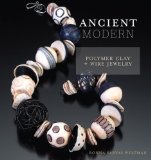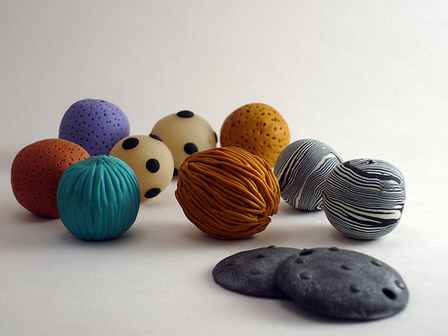Review: Ancient Modern by Ronna Sarvas Weltman

Ever heard of National Novel Writing Month (aka NaNoWriMo)? It's a yearly event where people sign up to write a 50,000-word novel in one month. It's exhilarating. It's crazy. And everybody should do it at least once. (When you do, read NanoWriMo founder Chris Baty's No Plot? No Problem!
first to get in the right frame of mind.)
While I'm sure Ronna Sarvas Weltman didn't write Ancient Modern: Polymer Clay + Wire Jewelry in a month, there's still something about it that reminds me of NaNoWriMo. But more on that in a minute.
The Book
The title Ancient Modern seemed a little odd to me, especially for work that looked to me to be primarily organic. Elsewhere it described itself as "elegantly primitive," which made more sense. Regardless of what you call it, the style is not for everyone. I personally think it's beautiful — but then again, that organic look has been trending in polymer clay for a while, so I've probably acquired a taste for it. My mother, on the other hand, glanced through the book and said, "There's some really ugly stuff in there, huh?" So, yeah, not for everyone. :-)
The book starts with a lengthy (33 pages) intro section that covers jewelry design, wire techniques and polymer clay basics. The sections on wire and polymer clay are good. But for me, the section on jewelry was the best part of the book. She starts by talking about the 6 principles of design, the color wheel and where to find inspiration. She then jumps into jewelry mechanics, giving suggestions for weighting the elements so necklaces, bracelets and rings hang correctly. She includes really helpful charts, like the one showing the names and ranges for standard necklace sizes (I'd never seen that before). The section for jewelry by itself would make the book worthwhile to beginning and intermediate jewelry-makers.
The Projects
Following the intro, Sarvas Weltman jumps into the projects. There are 15 projects, including 6 necklaces, 4 bracelets, 2 earrings, 2 rings and 1 brooch. Each of the projects is then broken down into multiple parts. For example, the first necklace has instructions for making 12 different beads.
Which brings me to my first small gripe. Each chapter has two large museum-style beauty shots at the beginning. Later, each bead has a few step-by-step photos. But she doesn't show detailed photos of each completed bead. So I kept having to flip back and forth to the beginning of the chapter to see which bead we might be working on now (the names weren't always helpful), and how the bead should end up looking. And in some cases, the beauty shots obscured some of the beads, making it hard to tell anything about the end result. While the beauty shots really give this book a nice look, it's important for an instructional book to have clear photos in the appropriate places.
The step-by-step photos are pretty good. I like that they were large enough to show detail. I wish they had lined up better with the text they were illustrating. This caused me a little confusion a couple of times, but it wasn't a big deal.
The instructions were well-written overall, but two things bugged me. First, the NaNoWriMo thing I mentioned earlier. See, one year my husband was getting close to the end of the month, and was short on word count (the goal is 50,000). So he introduced a plot element where time was repeating itself for his main character, sorta like in the movie Groundhog Day. After a few cut-and-pastes, he magically passed the word count. And since it was part of the plot, it wasn't necessarily against the rules. But still...
In Ancient Modern, the instructions for the Zebra Cane are repeated — THREE times — word for word. The wire-ball bead instructions are also repeated. This was probably just something they overlooked in the editing process. But even though there's plenty of other information in the book to make it worthwhile, those repeats made me feel a little cheated, like they were padding the book.
The second thing that bugged me was the other extreme. Often, instead of writing out the steps again, the author instructs you to repeat certain steps. While this is great in small doses, sometimes it would work better to just spell things out again to prevent confusion. For example:
Step 13: Repeat Steps 1-5 (on p. 48) twice to create a Ring Bead but make the cane in Step 2 with leftover Marble Mix from Step 1 and cover it with a thin sheet of black clay. In Step 4, blend the slices into the bead by rolling the bead between your palms.
This is even more confusing when the numbering gets messed up. Like where step 17 says to repeat 19-21, step 23 says to repeat 24-27, and step 19 says to repeat 19. (I'm lucky I didn't try that project, or I still might be stuck on step 19!) ;-)
Still, the instructions were easy to follow. It helps that the polymer clay techniques in this book are mostly pretty basic. The organic, imperfect style is always enjoyable because there really are no mistakes. It's all about creativity. So while I enjoyed making the beads, I doubt there's anything in here that an average clayer couldn't figure out on her own.
The average clayer might not be as familiar with the wire techniques Sarvas Weltman includes. I've always been less than enthusiastic about working with wire, and I hoped this book might help me get over that. And it might have. Unfortunately, I didn't realize good wire (she recommends sterling silver or copper) isn't available at Michaels or Hobby Lobby. (Are there other local stores that might sell this?) I'm intrigued enough by her instructions that I want to give it a try, but I haven't ordered any yet.
My Results
Since I couldn't find any wire — and pretty much all of the projects require wire — I just made some of the beads from the first necklace project. They were fun to make (no worries about perfection with this style), and they turned out pretty well. We'll see. I may get some wire and turn it into a necklace after all.
Summary
- Title: Ancient Modern: Polymer Clay + Wire Jewelry by Ronna Sarvas Weltman
- Price: $15.61 plus shipping
- Pros:
- Has the best jewelry design section I've seen.
- Cons:
- The clay techniques are pretty basic. Intermediate clayers could get bored.
- Who It's Good For:
- The clay techniques are definitely easy enough for beginners.
- Intermediate clayers may find the book worthwhile for its jewelry design tips, its wire-working tips, or just for inspiration.



Comments
Thanks for a great review- those gripes you mentioned were certainly valid. Just goes to show that craft books need great editors! Thanks again...Jenny
Posted by: Jenny Barnett Rohrs | July 10, 2009 8:20 AM
thanks for this review. i'm glad you were honest. too often book reviews sound like commercials, and their value is diminished. you can get wire from the rings and things catalog we got in our goodie bags. also, you can get copper wire at the hardware store. and sometimes rebar wire (also at the hardware store) is an interesting alternative.
Posted by: gerri newfry | July 23, 2009 8:53 AM
Thanks to you both. And great tips on the supplies, Gerri! Sounds like a trip to the hardware store is in order...
Posted by: Angela Mabray | August 7, 2009 2:49 PM
This is a great review! I am just starting out with clay, trying to make my own pendants and beads. I am curious, the picture you took of your finished beads looks very professional! What sort of camera and background did you use?
Posted by: Marianne | August 7, 2009 7:27 PM
Thanks for the compliment, Marianne! The camera's actually a fairly old one (as far as cameras go). It's a Sony Cyber-shot DSC-P100 with 5 Megapixels. My background is a plain white posterboard set up in a homemade lightbox. You can read more about my photo setup here: How to Take Better Photos of Your Work.
Posted by: Angela Mabray | August 8, 2009 12:59 AM
I actually like Ronna's book very much. I like the fact that the style is organic and not fussy or cute. The instructions are clear and the photos are excellent.
Posted by: Belle Kolste | February 14, 2010 3:50 PM
Thanks for the review. I purchased this book online and it was the first Polymer Clay book I returned because I was not happy with it. My gripes are the same as yours; repeated techniques and lack of completion photos.
Posted by: Rick Sharpe | July 6, 2010 9:41 AM
I loved this book and I love the style of the jewelry. Since I'm a wire jewelry maker first, I guess I never noticed what you did. I also never actually "read" books thoroughly, I just kinda look at the pictures and just read the parts I can't figure out! Still a lovely book to me, and I get inspired every time I look at it. A great book if you just look, get inspired, and get cracking.
Posted by: Christine | November 6, 2010 11:35 PM
Thanks for the comment, Christine. You're absolutely right that it's a good book for inspiration. And many readers do just as you do -- look at the photos and skim a few parts -- in which case the inspiration factor is really the main thing that matters. In fact, I'll admit that I rarely read a craft book cover-to-cover before I started reviewing them. But now that I do, I've found there's a lot more potential for learning. Even when I think I'm not interested in a particular project, I sometimes learn a technique I can apply elsewhere. In that way, reviewing craft books has challenged me to be a better reader. But it's also raised my standards, since I now notice (and am bothered) when instructions are repetitive or unclear.
Posted by: Angela Mabray | November 10, 2010 2:34 PM